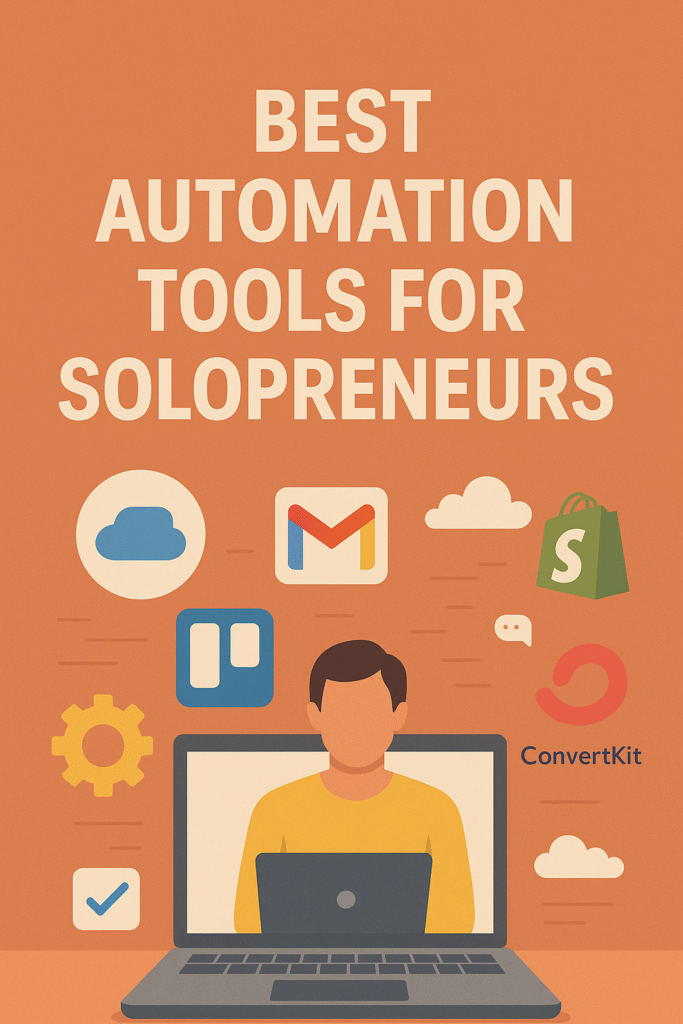
Best Automation Tools for Solopreneurs
Being a solopreneur is a rewarding yet challenging path. You wear every hat in your business—marketer, accountant, designer, strategist. And let’s be real, sometimes, it feels like juggling flaming swords while riding a unicycle uphill. That’s where automation steps in—not as a replacement for your creativity, but as your invisible team.
The Best Automation Tools for Solopreneurs can help you reclaim your time, reduce overwhelm, and focus on scaling. Whether you’re managing leads, sending emails, handling your finances, or scheduling posts, these tools can work around the clock so you don’t have to.
The Need for Automation as a Solopreneur
Time is the most precious currency for solo business owners. You can’t outsource to a team, and burnout is a real risk when you’re doing it all. Automation tools help you replace repetitive tasks with systems that run in the background. The goal? More time to focus on strategy, customer experience, and product development.
How Automation Can Transform Your Business
Here’s the irony: the more systems you put in place, the more personal your brand can feel. Why? Because automation gives you time to engage more deeply with your customers and show up consistently. Plus, it reduces human error, keeps your data organized, and ensures no lead falls through the cracks. That’s not just efficient—that’s smart
Criteria for Selecting Automation Software
Before diving into the tools, here’s a quick checklist to help evaluate them:
Scalability: Will it still serve you when you grow?
Ease of Use: You want less work, not a learning curve that needs a PhD.
Integration Capabilities: Does it play well with the rest of your stack?
Affordability: Solopreneurship often means bootstrapping. Look for value, not just features.
Support and Community: Can you get help when needed?

Time Management Solutions
Automating Task Management
Trello, Todoist, and ClickUp let you automate recurring tasks, assign due dates, and set reminders so nothing slips through the cracks.
Tools for Calendar and Scheduling Automation
Calendly and Google Calendar integrations help clients book time without the endless back-and-forth. Tools like Motion even prioritize your tasks dynamically.
Email Marketing Automation Platforms
Lead Generation and Nurturing
ConvertKit and MailerLite shine here. They allow you to build lead magnets and automatically send sequences that warm up leads over time.
Campaign Management and Analysis
ActiveCampaign adds depth with behavior-based automation and robust analytics to tweak your campaigns for better conversions.
Social Media Automation Tools
Automating Content Scheduling
Buffer, Publer, and SocialBee help you queue weeks of content in a single sitting, while keeping your social presence fresh and engaging.
Engagement and Monitoring
Tools like Agorapulse go beyond posting—they let you track mentions, respond to DMs, and analyze audience sentiment.
Financial and Accounting Automation
Expense Tracking and Reporting
QuickBooks and Wave can auto-categorize your expenses, generate reports, and even remind you of tax deadlines.
Automating Invoicing and Payments
FreshBooks allows you to automate recurring invoices and track time, making billing smooth and professional.

Project Management Automation Apps
ClickUp and Notion integrate with tools like Slack and Zapier to build workflows where project updates, task creation, and progress tracking happen without extra clicks.
Automating Online Workflow
Zapier and Make (formerly Integromat) are the kings of workflow automation. They act as digital glue, connecting apps and triggering actions across platforms—like saving email attachments to Drive or adding new leads to a spreadsheet.
Sales and CRM Automation Software
Automating Sales Pipelines
Pipedrive automates pipeline stages, scoring, and reminders, keeping your deals moving without micromanaging every step.
CRM Integration Capabilities
Zoho CRM supports integration with email, calendars, and even WhatsApp, helping you create a fully connected customer journey.
Content Creation and Curation Automation
Automating Content Distribution
Missinglettr auto-generates social campaigns from your blog posts and schedules them throughout the year.
Curating Content Automatically
Feedly and Quuu help you discover and share niche-relevant content without scouring the web for hours.
Boosting Efficiency with Personalization Automation
Tools like RightMessage let you personalize your site based on visitor behavior—showing tailored messages or offers depending on how they interact with your pages. It’s like rolling out the red carpet for each visitor.

Integration Capabilities of Automation
You might love ten different tools, but if they don’t talk to each other, it’s chaos. Tools with open APIs and Zapier support keep your tech stack smooth and your sanity intact.
Automating Repetitive Workflow Processes
Automating Your Online Store
Shopify Flow allows you to automate tasks like low-stock alerts, loyalty rewards, and customer tagging.
Inventory Management Automation
Tools like Zoho Inventory sync sales, update stock levels, and track shipments automatically, leaving you with fewer manual entries and fewer mistakes.
Analytics and Reporting Automation
Google Data Studio and DashThis pull your data from multiple platforms into sleek dashboards, so you can glance at key metrics without logging in everywhere.
Automating Customer Support Tasks
Chatbots like Tidio and HelpCrunch offer real-time responses and ticket creation, while knowledge base tools like HelpDocs serve customers even while you sleep.
Security and Compliance in Automation
Tools like LastPass (for password management) and Termly (for policy automation) help you stay compliant without legal headaches.
Common Pitfalls to Avoid in Automation
Automation shouldn’t be about removing the human touch. Over-automating can lead to a robotic experience. Test every workflow. And remember—some tasks need you, not a script.
Best Automation Tools for Solopreneurs: Our Final Thoughts
Building a business on your own terms is the ultimate freedom. But freedom needs support. The Best Automation Tools for Solopreneurs are your behind-the-scenes team, your midnight workers, your consistent performers. Choose the right ones, and they’ll help you scale without burnout, create without chaos, and grow without losing your mind.
FAQs
What are the best affordable automation tools for solopreneurs?
Tools like MailerLite, Wave, and Buffer offer robust features with generous free plans or low monthly costs, making them ideal for budget-conscious solopreneurs.
Can automation hurt my brand if overused?
Yes, too much automation can feel cold. Balance automation with personal engagement—use it to support, not replace, your unique voice.
Which is better: Zapier or Make?
Zapier is more user-friendly and has a larger app ecosystem. Make is more customizable and affordable for complex workflows.
How do I know if a task should be automated?
If it’s repetitive, rule-based, and doesn’t require creative input, it’s a good candidate for automation.
Are these automation tools beginner-friendly?
Most of them are. Tools like Trello, Calendly, and ConvertKit are designed with simplicity in mind and come with strong tutorials.
Do I need technical knowledge to automate workflows?
Not always. Many tools offer drag-and-drop builders and templates that require no coding. For advanced setups, a bit of learning or a freelance tech helper can go a long way.
Related Topics
Best Writing Tools for Students in 2025|Toolgenix



